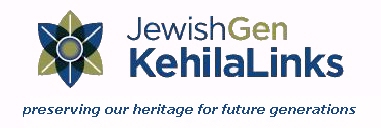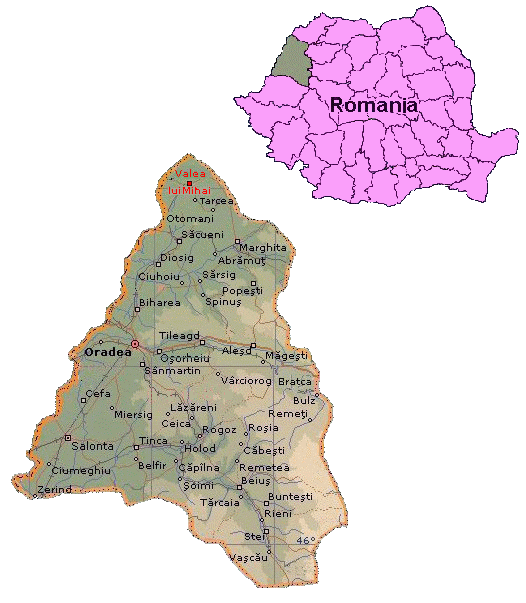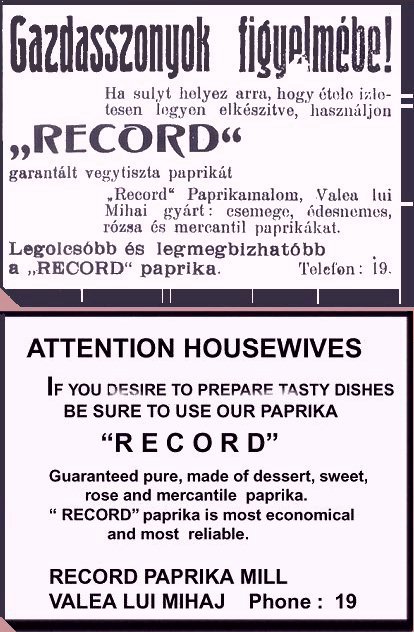|
||||||||
| also known as: Érmihályfalva (HU), Mihafalu (Ger), Mihályfalva (Yiddish) 47°31' N / 22°09' E |
||||||||
| ~ Introduction ~ |
||||||||
|---|---|---|---|---|---|---|---|---|
| ( Click the arrow in the buttons |
||||||||
|
||||||||
| ~ Maps ~ |
||||||||
| Bihar province, Romania Map: Copyright ©2009 by Marshall J. KATZ |
||||||||
|
||||||||
| NOTE: Clicking a link will open a new page. |
||||||||
|
||||||||
| ~ History ~ |
||||||||
| Jews from Galicia settled in Érmihályfalva (Valea lui Mihai) around 1780 and engaged in agriculture and commerce. Érmihályfalva was the center of Jewish life for the surrounding towns. In the beginning of the 19th century, around 1820, land was purchased for the synagogue and construction was started. On documents that have been found, they show the building was constructed in a short period of time and the first leaders were Sandor ROSENBERG, Jakab ROSENFELD, Izsak FELDMAN and Mendel OSTREICHER. In 1822, the first woman's Chevra Kadisha group was established and, in 1834, Solomon MINSZENTI was elected the first rabbi. |
||||||||
| In 1873, an elementary school with two teachers and 102 students was opened and attended by most of the children in the community. At the same time, a yeshiva was established with land donated by Lajos DANCZINGER, while Beno GLUCK donated the building materials. Talmud study was established at the suggestion of Jeno ZELLER. |
||||||||
| In 1877, the population of Valea lui Mihai was 3,901 made up of Hungarians, Rusyns and Jews and comprised the following religions: Roman Catholic (417); Greek Orthodox (407); Greek Catholic (1); Agnostic (18); Reformed (2,566), and Jewish (492). |
||||||||
| In 1878, thirty Hasidic rabbis convened in Valea lui Mihai to protest against the critical attitude of the Orthodox rabbis in Budapest. In the late 19th century, Anschel BAK opened a Hebrew printing press. |
||||||||
| In World War I, 15 Jewish men from Érmihályfalva died a heroic death. By 1920, the community was too large for its present synagogue, so the community the leader, President DANCZINGER, decided to build a new synagogue through the levying of an extra payment tax. The Jews of Valea lui Mihai were mainly business people employed in commerce and as professionals. By trade, there were three wholesalers, 105 businessmen, seven factory owners, 55 craftsman, four farm owners, three lawyers, one physician, two general proprietors, two office workers, four private offices, one teacher, eleven self-employed, 21 general laborers, eleven miscellaneous and 72 unemployed. |
||||||||
| The Jewish population of Valea lui Mihai, in 1930, was approximately 300 Jewish families or 1,430 Jewish inhabitants (20% of the total). In the inter-war period, Jews were leaders in the local industries employing hundreds of workers, and the better situated Jews contributed greatly to the industrial development of Valea lui Mihai, such as the Beno GLUCK mill, the Marton FREUND textile factory, the two window shade factories of WURDINGER-HOFFMANN and DETCH-FOLMANN and the cement-concrete and brick factory of Jeno KATZ. Furthermore, many people from Valea lui Mihai worked on farms, such as Karoly FELMANN, who owned 300 hectares, Zoltan BENEDEK, who owned 400 hectares, and Henrick ROSENFELD, who owned 480 hectares. |
||||||||
| Economic life, at this time, was difficult and the local Jewish community shouldered the Valea lui Mihai community's yearly expenses of 1,400,000 lei (Rumanian currency). The neighboring towns of Ersemjen, Erselind, Galospetri, Vasad, Otomany, Szalacs, Piskolt, Ertarcsa and Erkeseru also contributed in covering such a huge annual expense. Without their help, the taxpayer's burden would have been enormous. |
||||||||
At this time, the leaders of the Orthodox-based community were:
|
||||||||
| Zionist activity began, in the 1930's, with the establishment of youth groups. Valea lui Mihai was the site of the Ha-No'ar ha-Tziyyoni national convention. |
||||||||
| In the summer of 1941, ten families were expelled across the border into Ukraine and murdered in Kamets-Podolski. In May 1944, the Jewish community was transferred to the Oradea ghetto and then deported to Auschwitz. After the war some survivors returned, but soon left. |
||||||||
| Today, Valea lui Mihai is a large town of over 13,000 inhabitants. A number of Hungarians, Romanians, Roma and over twenty other nationalities live there. A great number of the Jews of Valea lui Mihai were murdered in the Holocaust. Only three elderly Jews live there today (2009). |
||||||||
| Source (portions): The Encyclopedia of Jewish Life Before and During the Holocaust, (2001), pp. 1372-73. |
||||||||
| ~ 1934 Valea lui Mihai Almanac ~ Directory Data: Copyright ©2009 by George WHITE, Canada |
||||||||
| Following are the contents of a 1934 almanac depicting the life of the community and the role its members played in it.
|
| Population in 1930 | ||||
|---|---|---|---|---|
| By Ethnic Origin | By Religion | |||
| Romanian | 1,382 | Greek Orthodox | 113 | |
| Hungarian | 5,687 | Greek Catholic | 1,269 | |
| Jewish | 1,641 | Reform | 4,639 | |
| Other | 1 | Roman Catholic | 998 | |
| Jewish | 1,641 | |||
| Total | 8,711 | Muslim | 1 | |
| Agnostic | 50 | |||
| Total | 8,711 | |||
| By 1943 the total population was closer to 12,000 and the Jewish population about 3,000. | ||||
| Health Care | ||
|---|---|---|
| Physicians | Dentists | |
| Dr. Ernö ANDRÁSSY | Dr. András BALAJTI | |
| Dr. Ludovic COZAC | Dr. László WEISZ | |
| Dr. Mrs. Ludovic COZAC | ||
| Dr. Sándor GRÓSZ | ||
| Dr. Jenö KLEIN | ||
| Akos MÁTRAI | ||
| Lawyers | ||
| Dr. Miklós BÁLINT | ||
| Dr. Sándor GLÜCK | ||
| Dr. Armin KÉPES | ||
| Dr. István SÓLYOM | ||
| Dr. Ernö JAKAB | ||
| Dr. Lajos MARKOVICS | ||
| Dr. Ignác BARTA | ||
| Dr. Emil MURESAN | ||
| Telephone Subscribers | ||||
|---|---|---|---|---|
| Name | Phone Number | Name | Phone Number | |
| Sheriff's Office | 1 | Béla GRÜNFELD | 14 | |
| Town hall | 2 | Border Police | 15 | |
| Dr. István SOLYOM | 3 | György KOLLING | 16 | |
| Henrik JAKABOVITS | 4 | Dr. ROXIN | 17 | |
| Transport Office | 5 | Tax Office | 18 | |
| Bonded warehouse | 6 | WEISZ and FISCH | 19 | |
| MIHELFI and KANDEL | 7 | S. ROSENFELD | 20 | |
| Granary | 8 | K. HOFFMAN | 21 | |
| Dr. Sándor GROSZ | 10 | Dávid BERGER | 22 | |
| POPPER and LÁZÁR | 12 | Customs Office | 23 | |
| Police Station | 13 | Dr. Ludovic COZÁR | 24 | |
| Village Management | |
|---|---|
| Position | Name |
| Councilors | Gheorge BOROS, Lajos PETHE, László WEISZ, Béla KÁDÁR |
| Notary | Victor T. FARKAS |
| Manager | Lajos SZALAI |
| Officials | Stefan ZIH, Stefan ZOO, Joan CUIBUS, Nicolae GOYA |
| Treasurer | Paul KOVÁCS |
| Bailiff | Aurel BOB |
| In addition, the village employed eight policemen, two tradesmen, three streetsweepers, two paid firemen, one ranger and a facilitator at the county court. | |
| Other Public Offices | |
| Petty Court | Tobacco Growers Office |
| County Court | Railway Station |
| Finance Office | Border Police |
| National Tax Office | Duty Office |
| Post and Telegraph Office | Notary Office |
| Telephone Exchange | County Health Office |
| Tobacco Exchange | County Veterinary Office |
| Places of Worship | |
|---|---|
| Greek Orthodox | |
| Greek Catholic | |
| Reform | |
| Roman Catholic | |
| Orthodox Jewish | |
| Baptist | |
| Schools | ||||
|---|---|---|---|---|
| Type | Number Students | |||
| State elementary school, four grades | 627 | |||
| Reform Co-Ed | 230 | |||
| Roman Catholic Co-Ed | 60 | |||
| Orthodox Jewish Co-Ed trade school | 120 | |||
| Valea lui Mihai Associations | |
|---|---|
| Kaszinó (country club) | Country Hungarian Party |
| Rumanian Kaszinó | National Liberal Party |
| Tradesmen's Assoc. | National Peasant Party |
| Rumanian Ladies Club | Jewish Party |
| Reform Ladies Club | -Chairman J DEUTCH |
| Reform Girls Club | -Deputy Chairman: |
| Reform Mixed Quire | K. HOFFMAN, Géza FISCH |
| Catholic Housewives Union | -Attorney Dr. A. KEPES |
| -Secretary S. ROSENBLÜTH | |
| Jewish Associations | ||
|---|---|---|
| Ladies Club | National Union | |
| -Chair Paula FISCH | -Chair Dr. A. KEPES | |
| -Deputy Chair M. GOLDSTEIN | -Deputy Chairmen: J. DEUTCH, | |
| -Treasurer M. FRIEDMAN | K. FELDMANN, M. GRÜNFELD | |
| -Controller J. DEUTCH | Dr. S. GRÓSZ | |
| -Secretary B. ABRAHAM | -Manager Dr. A. BALAJTI | |
| Girls Club | -Deputy Managers: Géza FISCH, | |
| -Chair I. ROSENFELD | Sándor WEISZ, M. GOLDSTEIN | |
| -Deputy Chair H. KLEIN | -Secretary O. GLÜCK | |
| -Secretary Lili WEISZ | -Treasurer H. LÖRINCZ | |
| -Treasurer J. FELDMANN | -Controller K. GLÜCK | |
| -Controllers: Sz. GRÜNBERG, D. HOFFMAN | ||
| Palestine Office | ||
| Mizrachi CEIRE | ||
| Mizrachi CEIROTH | ||
| Hacioni HANOAR | ||
| Zionist Women's World Association | ||
| -Chair Dr. Mrs. M. BÁLINT | ||
| -Deputy Chair Mrs. S. JACOBOVITS | ||
| -Treasurer Mrs. E. GROSINGER | ||
| -Controller Béláné (Ella) WEISZ | ||
| -Secretary F. BLUM | ||
| -Cultural Chair Rózsi ORENSTEIN | ||
| This page is hosted at no cost to the public by JewishGen, Inc., a non-profit
corporation. If you feel there is a benefit to you in accessing this site, your JewishGen-erosity is appreciated. |
| Created by: Marshall J. KATZ, USA Compiled by: Eugene KATZ, USA with assistance from City of Valea lui Mihai Town Hall Updated Jul 2021 BAE Nevek-Klarsfeld David ADMONI, Israel Imre GROSINGER, USA Elly (née BERKOVITS) GROSS, USA Fulop JOSKA, Érmihályfalva Bela and Eszter KISS, Érmihályfalva Zsolt KISS, Érmihályfalva Istvan MAGYAR, Érmihályfalva Csaba RENCZ, Érmihályfalva Istvan SZILAGI, Érmihályfalva Michael VALLEY, Érmihályfalva Amos Israel ZEZMER, France and the following JewishGen members/descendants and contributors of Valea lui Mihai Jewish families: Rifky (née ROTH) ATKIN, USA Dorothy BERNSTEIN, USA Tereze GLUCK, USA Lajcsi Itzhak GROSZ, Israel A. Tom GRUNFELD, USA Veronica/Vera (née SOLOMON) HECHT, USA Herman KAHAN, USA Eugene KATZ, USA Fran MENG, USA Sophie (née WEISZ) MIKLOS, USA Yishay ROTH, Israel Ari TESLER, Belgium George WHITE, Canada Miriam (née GOLDSTEIN) YAGODA, Israel |
| Updated: 22 August 2020 |
|---|
| Copyright ©2009 Eugene KATZ All rights reserved. |
|
||||||||||
| Visitors since: 28 April 2009 |
|---|





